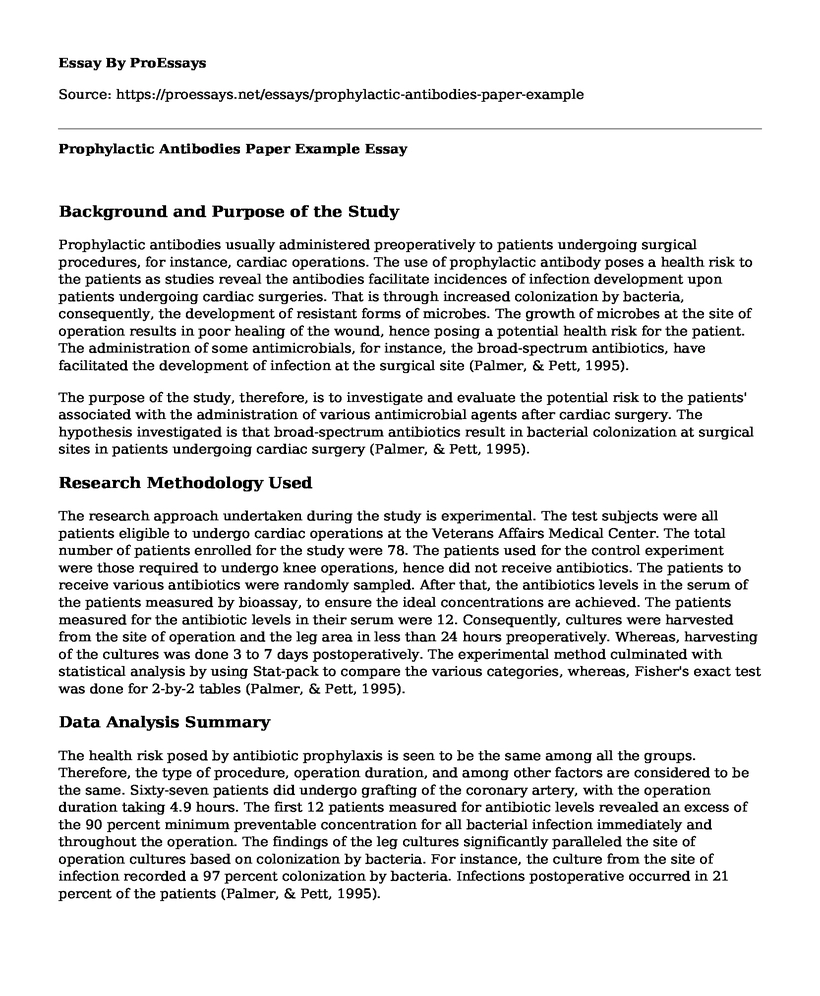Background and Purpose of the Study
Prophylactic antibodies usually administered preoperatively to patients undergoing surgical procedures, for instance, cardiac operations. The use of prophylactic antibody poses a health risk to the patients as studies reveal the antibodies facilitate incidences of infection development upon patients undergoing cardiac surgeries. That is through increased colonization by bacteria, consequently, the development of resistant forms of microbes. The growth of microbes at the site of operation results in poor healing of the wound, hence posing a potential health risk for the patient. The administration of some antimicrobials, for instance, the broad-spectrum antibiotics, have facilitated the development of infection at the surgical site (Palmer, & Pett, 1995).
The purpose of the study, therefore, is to investigate and evaluate the potential risk to the patients' associated with the administration of various antimicrobial agents after cardiac surgery. The hypothesis investigated is that broad-spectrum antibiotics result in bacterial colonization at surgical sites in patients undergoing cardiac surgery (Palmer, & Pett, 1995).
Research Methodology Used
The research approach undertaken during the study is experimental. The test subjects were all patients eligible to undergo cardiac operations at the Veterans Affairs Medical Center. The total number of patients enrolled for the study were 78. The patients used for the control experiment were those required to undergo knee operations, hence did not receive antibiotics. The patients to receive various antibiotics were randomly sampled. After that, the antibiotics levels in the serum of the patients measured by bioassay, to ensure the ideal concentrations are achieved. The patients measured for the antibiotic levels in their serum were 12. Consequently, cultures were harvested from the site of operation and the leg area in less than 24 hours preoperatively. Whereas, harvesting of the cultures was done 3 to 7 days postoperatively. The experimental method culminated with statistical analysis by using Stat-pack to compare the various categories, whereas, Fisher's exact test was done for 2-by-2 tables (Palmer, & Pett, 1995).
Data Analysis Summary
The health risk posed by antibiotic prophylaxis is seen to be the same among all the groups. Therefore, the type of procedure, operation duration, and among other factors are considered to be the same. Sixty-seven patients did undergo grafting of the coronary artery, with the operation duration taking 4.9 hours. The first 12 patients measured for antibiotic levels revealed an excess of the 90 percent minimum preventable concentration for all bacterial infection immediately and throughout the operation. The findings of the leg cultures significantly paralleled the site of operation cultures based on colonization by bacteria. For instance, the culture from the site of infection recorded a 97 percent colonization by bacteria. Infections postoperative occurred in 21 percent of the patients (Palmer, & Pett, 1995).
Summary of Discussion
The use of antibiotic prophylaxis results in a greater chance of wound infection, for instance, the development of gram-negative bacteria at the surgical site. The bacterial infection colonizes the site of operation, consequently becoming resistant to perioperative antibiotic administered to the patient. Generally, the use of antibiotics results in health concerns to the patients due to the development of bacterial infection. However, broad-spectrum antibiotics are associated with increased risk of infection as compared to the narrow-spectrum antibiotics (Palmer, & Pett, 1995).
Limitations of the Study
Many studies are associated with the use of antimicrobial agents after the surgical operation. As a result, this research on the use of antibiotics may not have sufficient backing, especially during the review of literature phase.
Implications
The study will facilitate clinical practices to shift from the use of broad-spectrum to narrow spectrum antimicrobial agent for perioperative prophylaxis. Moreover, since the research is not conclusive, additional research on the subject will find a point of reference to build on. Also, the study can be used by medical students to employ the use of these guidelines during training operations, hence enhance patients' safety after surgery.
Reference
Palmer, D., & Pett, S. (1995). Bacterial Wound Colonization After Broad-Spectrum Versus Narrow-Spectrum Antibiotics.
Cite this page
Prophylactic Antibodies Paper Example. (2022, Nov 07). Retrieved from https://proessays.net/essays/prophylactic-antibodies-paper-example
If you are the original author of this essay and no longer wish to have it published on the ProEssays website, please click below to request its removal:
- HSE-101: Course Learning Outcome
- St. John Hospital and Medical Center SWOT Analysis
- Impacts of Stigma on Diabetes - Paper Example
- Breastfeeding, Family Socioeconomic, Parenting Behaviors: Impact on Academic Achievement
- Nursing Study Finds Positive Impact of Managing Disagreements - Essay Sample
- Alberta Project APPLE Schools: A Health Promotion Program - Essay Sample
- Essay Example on Covid-19: Global Economic Impact & Government Measures







